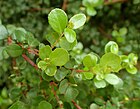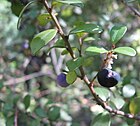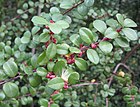Note: This is a project under development. The articles on this wiki are just being initiated and broadly incomplete. You can Help creating new pages.
Myrsine africana
Myrsine africana is also called Cape myrtle. It is a species of shrub in the family Primulaceae. It is indigenous to Macaronesia, Africa and South Asia. It typically has dense, dark-green to red foliage and produces tiny bright purple berries.
Contents
- 1 Uses
- 2 Parts Used
- 3 Chemical Composition
- 4 Common names
- 5 Properties
- 6 Habit
- 7 Identification
- 8 List of Ayurvedic medicine in which the herb is used
- 9 Where to get the saplings
- 10 Mode of Propagation
- 11 How to plant/cultivate
- 12 Commonly seen growing in areas
- 13 Photo Gallery
- 14 References
- 15 External Links
Uses
Parts Used
Chemical Composition
Lead (0.291 mg Kg-1), cadmium (0.780 mg Kg-1), chromium (0.172 mg Kg-1) and cobalt was found maximum in root parts whereas iron (414.0 mg Kg-1), zinc (68.33 mg Kg-1) and copper (60.33 mg Kg-1) was recorded in leaves.[1]
Common names
| Language | Common name |
|---|---|
| Kannada | |
| Hindi | Bandraru oleander, Banwa |
| Malayalam | |
| Tamil | |
| Telugu | |
| Marathi | NA |
| Gujarathi | NA |
| Punjabi | NA |
| Kashmiri | NA |
| Sanskrit | Vidanga |
| English | Cape Myrtle, African |
Properties
Reference: Dravya - Substance, Rasa - Taste, Guna - Qualities, Veerya - Potency, Vipaka - Post-digesion effect, Karma - Pharmacological activity, Prabhava - Therepeutics.
Dravya
Rasa
Guna
Veerya
Vipaka
Karma
Prabhava
Habit
Identification
Leaf
| Kind | Shape | Feature |
|---|---|---|
| Simple | Round in outline | The fine-toothed leaves are at first deep red, but on maturity become glossy and dark green. |
Flower
| Type | Size | Color and composition | Stamen | More information |
|---|---|---|---|---|
| Small | Cream white turns to red | Separate shrubs produce either male or female flowers, with the female plants producing purple berries. The hardy plant is long-lived. |
Other features
List of Ayurvedic medicine in which the herb is used
Where to get the saplings
Mode of Propagation
How to plant/cultivate
A plant of the drier tropics and subtropics, where it is found at elevations up to 3,800 metres.[3]
Commonly seen growing in areas
Photo Gallery
References
External Links
- Ayurvedic Herbs known to be helpful to treat Dropsy
- Ayurvedic Herbs known to be helpful to treat Colic
- Herbs with Fruits used in medicine
- Herbs with Leaves used in medicine
- Herbs with common name in Hindi
- Herbs with common name in Sanskrit
- Herbs with common name in English
- Habit - Long Herbs
- Index of Plants which can be propagated by Seeds
- Herbs that are commonly seen in the region of Tropical zones
- Herbs
- Myrsinaceae




